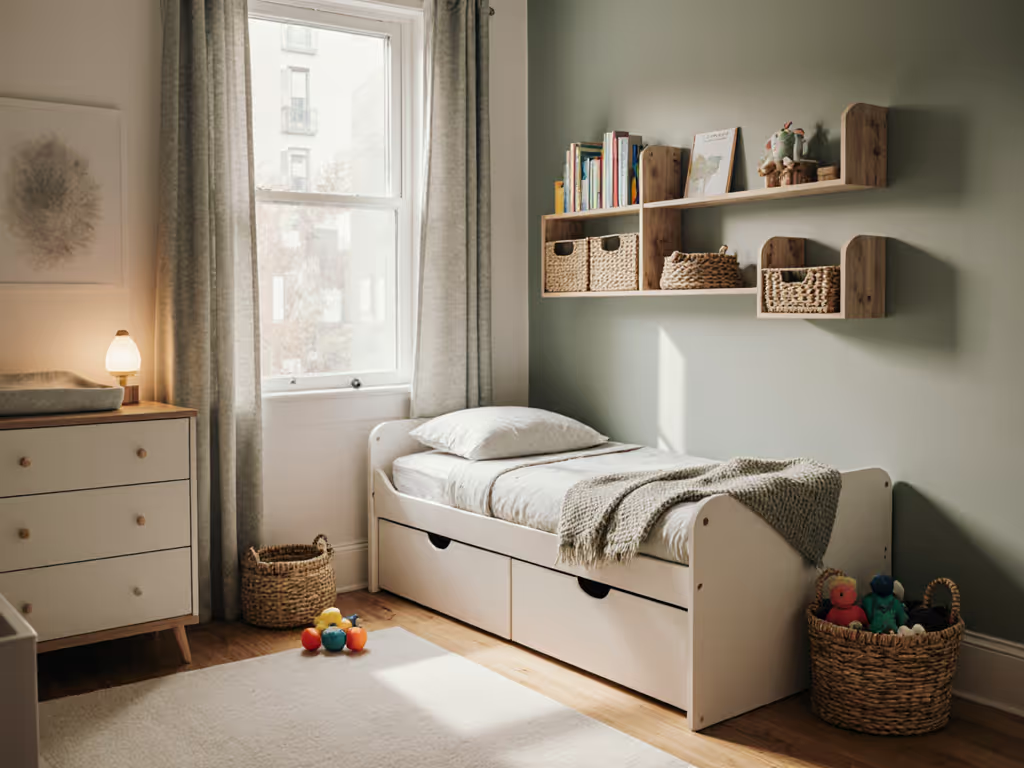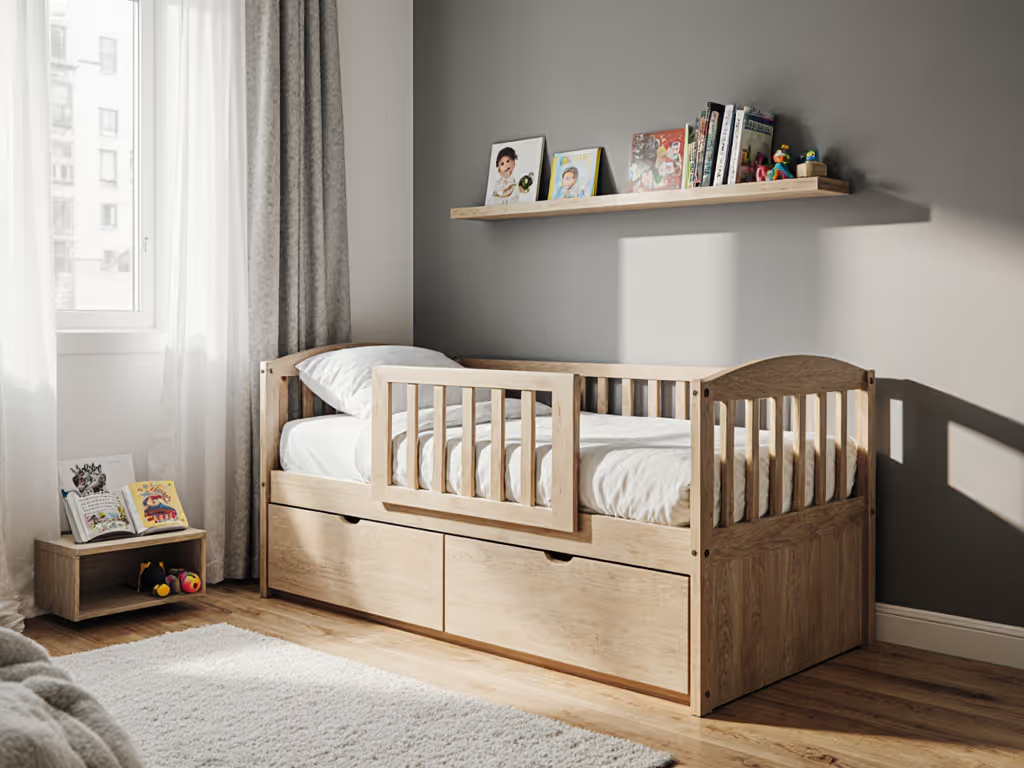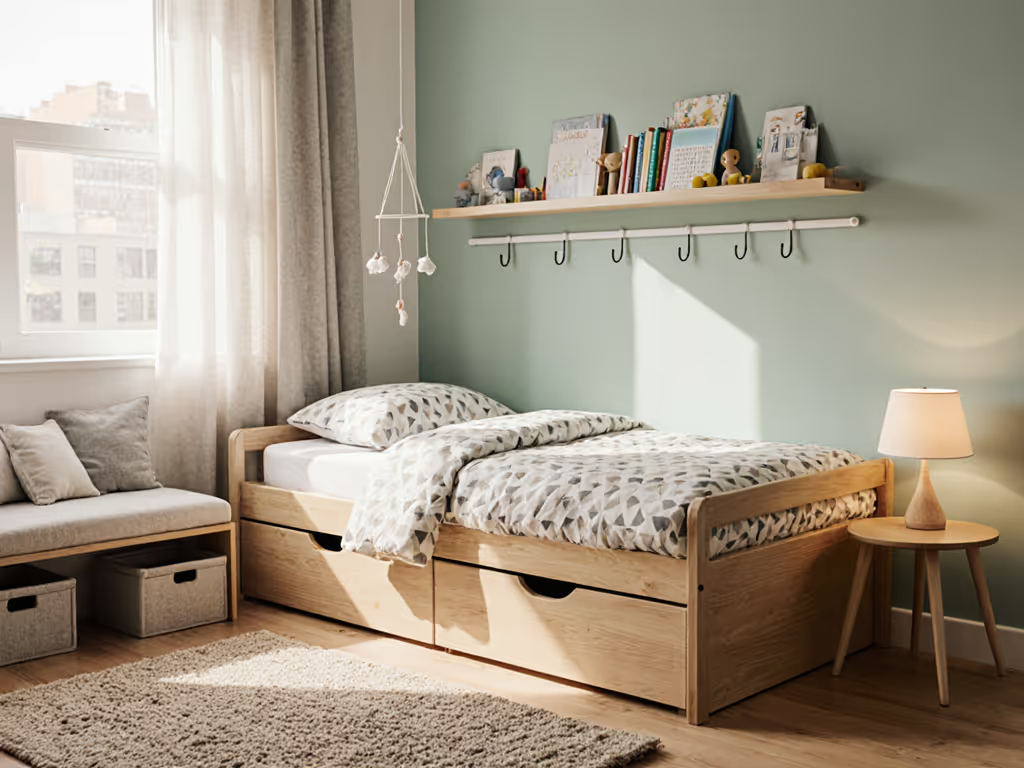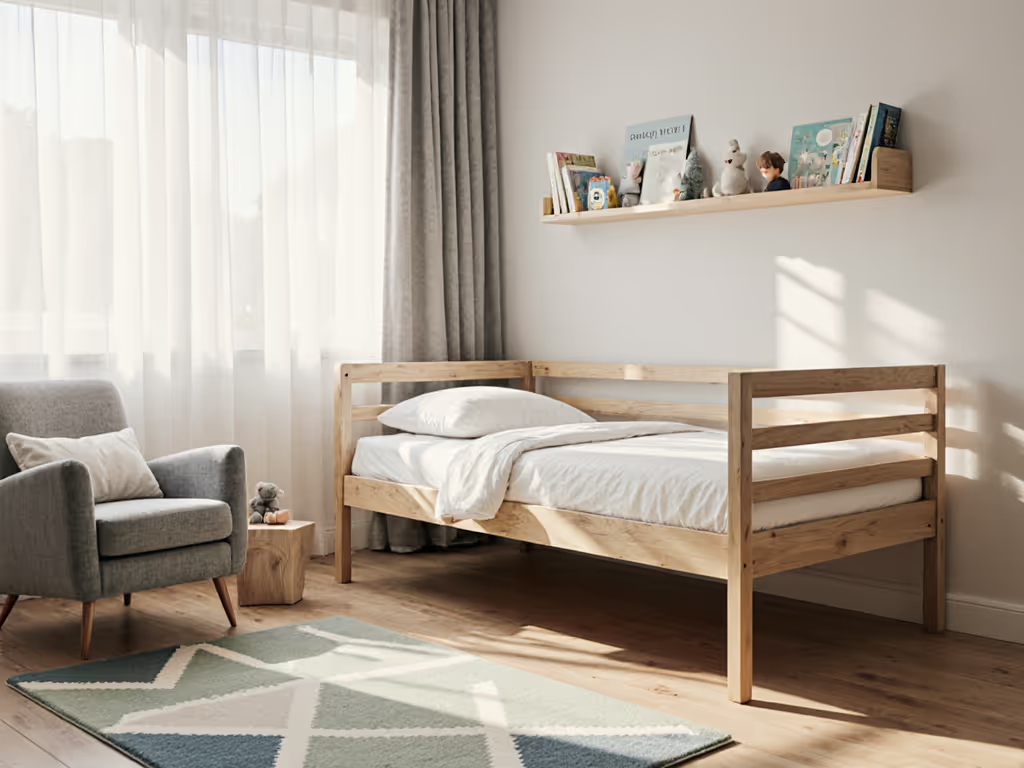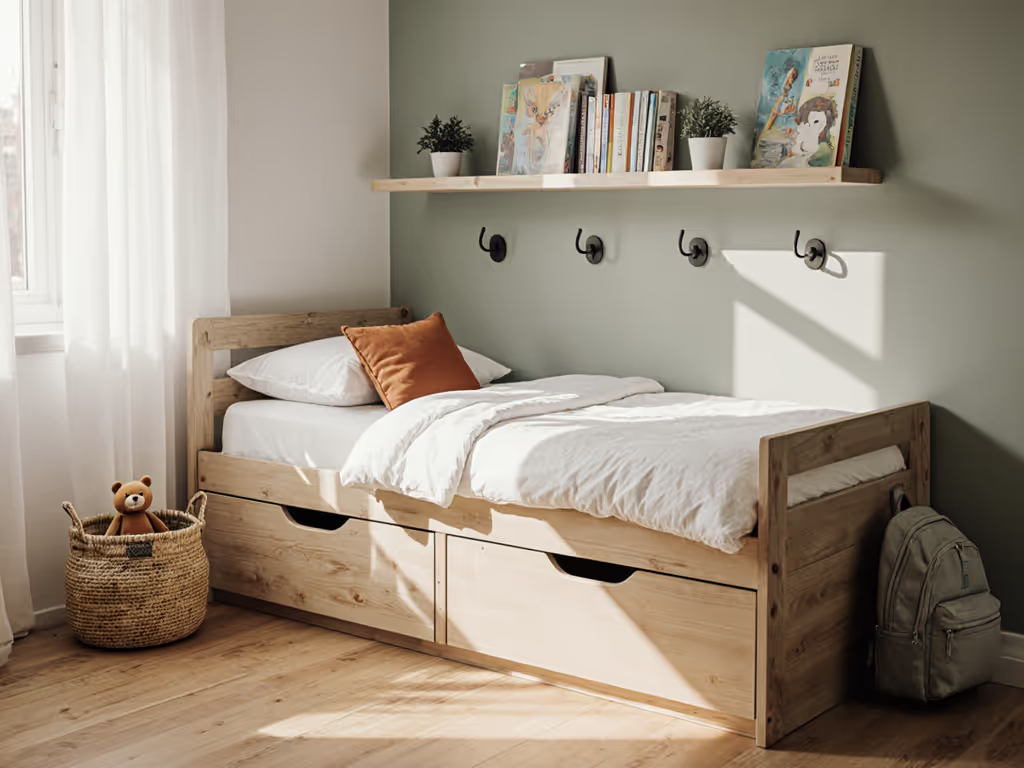
Under-Bed Storage in Small Rooms: Complete Guide
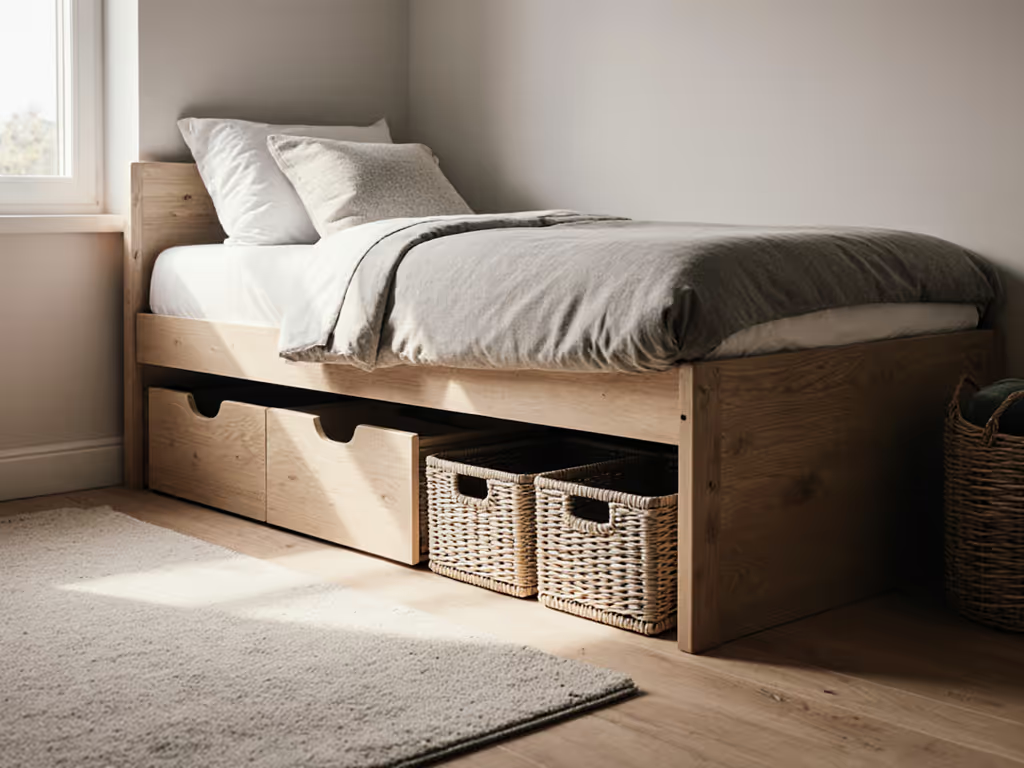
Did you know that over 60 percent of parents in small apartments say storage is their biggest organizing challenge? When every inch matters, finding hidden places for toys and clothes makes a real difference. Under-bed storage turns overlooked space into a smart solution, helping families keep bedrooms tidy without crowding the floor. Discover proven ways to use this hidden area for better organization and daily peace of mind.
Key Takeaways
| Point | Details |
|---|---|
| Maximize Space | Under-bed storage effectively transforms unused areas into functional organizational zones, essential for small living spaces. |
| Choose Appropriate Solutions | Select from various types of under-bed storage solutions tailored to specific needs, such as rolling containers for toys or vacuum-sealed bags for bulky items. |
| Prioritize Safety | Implement childproofing strategies, including secure attachments and smooth mechanisms, to ensure a safe environment for children. |
| Maintain Organization | Develop a systematic approach to categorize and label items, allowing for easy retrieval and adaptability as family needs change. |
Defining Under-Bed Storage for Small Rooms
When space is tight and every square inch counts, under-bed storage becomes a game-changing solution for parents juggling limited square footage. It's more than just shoving boxes under the mattress. Think of it as a strategic approach to maximizing bedroom real estate while keeping your toddler's room organized and functional.
Under-bed storage transforms the typically unused space beneath a bed into a smart, accessible organizational system. Unlike traditional storage methods that consume additional floor space, this approach cleverly utilizes an area that would otherwise remain empty. For parents in small apartments or shared bedrooms, this means creating extra room for toys, seasonal clothing, extra bedding, and other essential items without cluttering precious living spaces.
Effective under-bed storage solutions can be categorized into several key types:
- Rolling Containers: Wheeled storage boxes that slide easily in and out
- Drawer Systems: Built-in or standalone drawer units designed to fit specific bed frames
- Vacuum-Sealed Bags: Ideal for compressing bulky items like blankets and winter clothing
- Specialized Organizers: Segmented containers for toys, books, and small accessories
The magic of under-bed storage lies in its versatility. Whether you're dealing with a tiny urban apartment or a compact child's bedroom, these solutions offer a clean, efficient way to manage belongings without sacrificing style or accessibility. By thinking vertically and utilizing often-overlooked spaces, parents can transform cluttered rooms into organized, peaceful environments.
Types of Under-Bed Storage Solutions Explained
Navigating the world of under-bed storage solutions can feel like solving a complex puzzle for parents seeking smart organization strategies. Each storage type offers unique advantages, transforming that seemingly dead space beneath your child's bed into a functional organizational powerhouse.
Understanding these options helps you select the perfect storage system that matches your specific needs, room layout, and lifestyle.
Traditional storage solutions come in several primary categories, each designed to address different organizational challenges.
Here's a comparison of the main types of under-bed storage solutions:
| Storage Type | Best For | Key Benefits |
|---|---|---|
| Rolling Containers | Toys, daily clothing | Easy access<br>Moves smoothly |
| Drawer Systems | Books, regular essentials | Organized<br>Integrated with bed |
| Vacuum-Sealed Bags | Blankets, winter clothes | Space-saving<br>Compresses bulky items |
| Fabric Storage Boxes | Accessories, seasonal items | Lightweight<br>Collapsible |
| Wooden Drawer Units | Heavier items, aesthetics | Durable<br>Blends with decor |
| Segmented Organizers | Socks, craft supplies | Categorization<br>Quick retrieval |
For parents dealing with extreme space constraints, more specialized storage options emerge:
- Vacuum-Sealed Bags: Compress bulky items like winter coats and blankets
- Fabric Storage Boxes: Lightweight, collapsible options with soft sides
- Wooden Drawer Units: Sturdy, aesthetic solutions that integrate seamlessly with bed frames
- Segmented Organizers: Designed specifically for categorizing small items like socks, accessories, and craft supplies
Choosing the right under-bed storage isn't just about capacity - it's about creating a system that grows with your family's changing needs.
 Consider factors like weight capacity, material durability, ease of cleaning, and how seamlessly the storage solution integrates with your existing bedroom aesthetic. The goal is a storage approach that feels less like a compromise and more like a strategic design choice that simplifies your daily life.
Consider factors like weight capacity, material durability, ease of cleaning, and how seamlessly the storage solution integrates with your existing bedroom aesthetic. The goal is a storage approach that feels less like a compromise and more like a strategic design choice that simplifies your daily life.
Key Benefits for Space-Constrained Bedrooms
When square footage feels like a precious commodity, under-bed storage emerges as a superhero solution for parents navigating tight living spaces. It's not just about hiding away items - it's a strategic approach to transforming seemingly unusable areas into functional organizational zones that breathe life into cramped bedrooms. Parents struggling with limited room can reclaim valuable floor space and create a more open, breathable environment.
The primary advantage of under-bed storage lies in its ability to maximize spatial efficiency without compromising room aesthetics. Vertical space utilization becomes a game-changing strategy, allowing parents to store multiple items in a single, compact location. By leveraging the area beneath the bed, you effectively create an additional storage zone that doesn't interfere with the room's visual flow or play areas. This approach is particularly critical for families living in apartments, shared bedrooms, or homes with minimal storage options.
Key benefits of implementing under-bed storage include:
- Clutter Reduction: Eliminates visible mess and creates a cleaner room appearance
- Space Optimization: Converts unused areas into functional storage zones
- Accessibility: Keeps frequently used items within easy reach
- Cost-Effective: Eliminates need for additional storage furniture
- Adaptability: Solutions can grow and change with your family's needs
Beyond physical organization, under-bed storage offers psychological benefits that transform how families interact with their living spaces. By creating intentional storage solutions, parents can reduce visual chaos, promote a sense of calm, and teach children valuable organizational skills. The key is selecting storage systems that not only fit physically but also integrate seamlessly with your lifestyle, turning potential storage challenges into opportunities for smarter, more efficient living.
Safety, Accessibility, and Childproofing Factors
When implementing under-bed storage in a child's room, safety becomes the paramount concern. Parents must view these storage solutions not just as organizational tools, but as potential interaction zones that require careful design and strategic planning. The wrong storage approach can create unintended hazards, transforming what should be a helpful solution into a potential risk zone for curious and adventurous toddlers.
Childproofing under-bed storage involves multiple layers of strategic consideration. This means selecting containers with secure, child-resistant mechanisms, ensuring smooth rolling mechanisms that prevent pinched fingers, and choosing materials that are lightweight yet durable. Soft-close drawers, rounded edges, and non-toxic materials become critical factors. Parents should also consider the height and accessibility of storage units, ensuring that children cannot accidentally climb into or become trapped within storage compartments.
Key safety and accessibility strategies include:
- Secure Attachment: Anchor storage units to prevent potential tip-over risks
- Smooth Mechanisms: Use drawers with soft-close features to prevent finger injuries
- Height Considerations: Keep storage low enough to prevent climbing temptations
- Material Selection: Choose non-toxic, splinter-free materials
- Regular Inspection: Routinely check storage units for wear, damage, or potential hazards
Beyond physical safety, accessibility plays a crucial role in making under-bed storage functional for families. The ideal storage solution should allow easy retrieval for parents while remaining challenging for young children to open independently. This delicate balance requires thoughtful design - perhaps using sliding mechanisms with gentle resistance or incorporating child-safe locks that are simple for adults to operate but difficult for small hands to manipulate. Remember, the goal is creating a storage system that protects, organizes, and adapts to your family's evolving needs.
Maximizing Organization and Long-Term Usability
Transforming under-bed storage from a cluttered catch-all into a systematically organized space requires more than just purchasing containers. It demands a strategic approach that evolves with your family's changing needs. Parents must think beyond immediate storage solutions and design systems that can adapt, grow, and remain functional through different stages of childhood.
The foundation of long-term organization lies in intentional categorization and labeling. This means creating a logical system where every item has a designated place, making retrieval and storage intuitive. Transparent containers, color-coded labels, and modular storage units allow parents to quickly identify contents without endless searching. Consider developing themed containers - one for seasonal clothing, another for outgrown toys, and a separate unit for keepsakes - which helps maintain a clear, structured approach to under-bed storage.
Key strategies for maintaining organization include:
- Regular Inventory Checks: Review stored items every 3-4 months
- Seasonal Rotation: Swap out contents based on current needs
- Uniform Container Systems: Use matching containers for visual consistency
- Digital Tracking: Maintain a simple inventory list of stored items
- Purge and Replace: Remove unnecessary items to prevent overcrowding
Long-term usability isn't just about current storage needs - it's about creating a flexible system that can transform alongside your family's growth. Invest in adjustable storage solutions that can be reconfigured as your child transitions from toddler to school-age. Modular designs with interchangeable components allow you to modify storage approaches without completely replacing your existing system, ensuring your under-bed storage remains a dynamic, practical asset throughout your child's developmental stages.
Unlock Space and Safety with Smart Toddler Bed Choices
Struggling to maximize limited bedroom space while keeping your toddler's area safe and organized is a common challenge for parents. This complete guide on under-bed storage highlights how turning unused spaces into efficient storage zones can reduce clutter and create a calming environment. But optimizing small rooms goes beyond storage solutions. The right toddler bed design that balances safety, durability, and space optimization plays a crucial role in creating an organized and kid-friendly bedroom.
Explore expert advice on selecting toddler beds that complement your under-bed storage strategy by visiting City Toddler Beds. Discover practical tips on safety standards and space-saving designs that grow with your child’s needs. Don't wait to transform your toddler's room into a peaceful, clutter-free haven. Find your ideal toddler bed today and take the first step toward smarter bedroom organization with trusted resources and guides. Make room for peace of mind and enjoy a functional, beautiful space that adapts as your child grows.
Frequently Asked Questions
What types of under-bed storage solutions are available?
Under-bed storage solutions include rolling containers, drawer systems, vacuum-sealed bags, fabric storage boxes, wooden drawer units, and segmented organizers. Each type offers unique advantages tailored to different storage needs.
How can I make under-bed storage safe for my child?
To ensure safety, choose containers with secure, child-resistant mechanisms, use features like soft-close drawers to prevent finger injuries, and select materials that are lightweight and non-toxic. Regularly inspect the units for wear and potential hazards.
What are the benefits of using under-bed storage in small bedrooms?
Under-bed storage maximizes spatial efficiency by utilizing otherwise unused space, reduces visible clutter, keeps frequently used items easily accessible, and eliminates the need for additional storage furniture, creating a cleaner and more organized room.
How can I maintain organization in my under-bed storage?
Maintain organization by conducting regular inventory checks, implementing a seasonal rotation of items, using uniform container systems for visual consistency, and employing labeling strategies for easy identification of contents.

